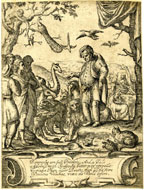The age of Hollar and Stent
 The middle years of the 17th
century were pivotal in the history of British printmaking, and two figures are crucial. The
first was the Bohemian artist, Wenceslaus Hollar, who was taken into the service of the Earl
of Arundel during his European tour in the 1630s, returning with him to England where he was
to remain for much of the rest of his life. Hollar was not only an exquisitely talented
artist but also an extraordinarily prolific one, and our view of Britain in his period
arguably owes more to him than to anyone else. He produced topographical prints, including
the famous Long View of London and many related scenes and maps. He also produced prints of
virtually every other type that was by now established in this country, from portraits and
allegories to natural history prints and satires. Hollar’s work has long been well known,
and it is well represented in the bpi1700 corpus, though we do not pretend to offer a
comprehensive series of his works, for which users should go to the Wenceslaus Hollar Digital Collection at the
University of Toronto.
The middle years of the 17th
century were pivotal in the history of British printmaking, and two figures are crucial. The
first was the Bohemian artist, Wenceslaus Hollar, who was taken into the service of the Earl
of Arundel during his European tour in the 1630s, returning with him to England where he was
to remain for much of the rest of his life. Hollar was not only an exquisitely talented
artist but also an extraordinarily prolific one, and our view of Britain in his period
arguably owes more to him than to anyone else. He produced topographical prints, including
the famous Long View of London and many related scenes and maps. He also produced prints of
virtually every other type that was by now established in this country, from portraits and
allegories to natural history prints and satires. Hollar’s work has long been well known,
and it is well represented in the bpi1700 corpus, though we do not pretend to offer a
comprehensive series of his works, for which users should go to the Wenceslaus Hollar Digital Collection at the
University of Toronto.
However, Hollar’s own output has in the past sometimes obscured the extent to which print
production burgeoned more generally in the middle decades of the century. Here, the key
figure was the dealer, Peter Stent, who flourished from
 c. 1642 until his death in the Great Plague in 1665. The date of his
emergence is significant, because the context was clearly provided by the outbreak of the
Civil War: this led to a rising demand for topical engravings which made possible their
production and dissemination on a commercial scale that had not previously been viable.
Stent rose to this challenge, mass-producing engravings of subjects linked to the War, in
the form of portraits of the commanders on both sides, maps of battles, political satires
and the like. But he was also able to appeal to a wider range of tastes,
c. 1642 until his death in the Great Plague in 1665. The date of his
emergence is significant, because the context was clearly provided by the outbreak of the
Civil War: this led to a rising demand for topical engravings which made possible their
production and dissemination on a commercial scale that had not previously been viable.
Stent rose to this challenge, mass-producing engravings of subjects linked to the War, in
the form of portraits of the commanders on both sides, maps of battles, political satires
and the like. But he was also able to appeal to a wider range of tastes,
 as is illustrated by the range of material that
appears in an advertisement that he produced in 1654, the first such advertisement of
printed images to survive. This includes portraits, genre prints, sets of engravings of
flowers and animals, maps and copy books.
as is illustrated by the range of material that
appears in an advertisement that he produced in 1654, the first such advertisement of
printed images to survive. This includes portraits, genre prints, sets of engravings of
flowers and animals, maps and copy books.
In order to meet the demand for printed images of all kinds, Stent employed a range of artists, including not only Hollar but also native born engravers like the prolific but elusive Richard Gaywood. Such men also found employment in other unprecedented enterprises of the Interregnum years. It was now that the entrepreneur John Ogilby produced the first of a series of books illustrated with lavish engravings, including editions of Aesop and Virgil, and the antiquary, Sir William Dugdale, pioneered the production of engravings of medieval cathedrals, abbeys and churches to illustrate the first volume of the great Monasticon Anglicanum that he produced with Roger Dodsworth. In all, the middle decades of the 17th century were a period of extraordinary innovation in the trade in printed images.